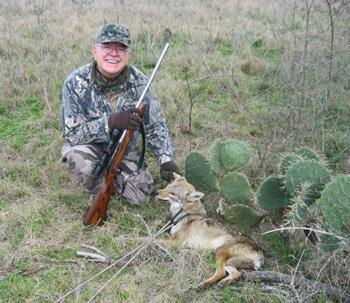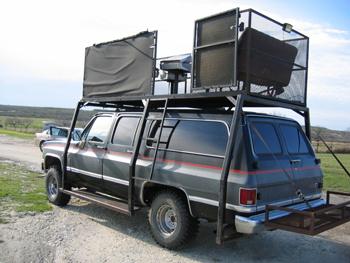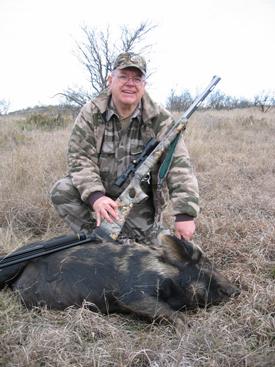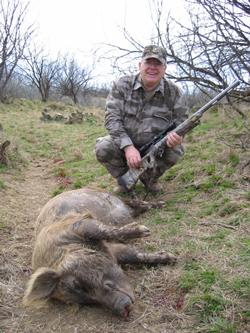Trigger Time In Texas
By Ian McMurchy
In March I made an interesting trip south to test new guns and ammo – and to escape Saskatchewan's rotten winter. I flew into San Antonio to meet Kevin Howard from Howard Communications in Missouri. Kevin arranges "writer-hunts" for several companies and he is very good at his job. I met a good group of writers and industry folk and we proceeded to shoot a whole bunch of .223 WSSM ammo.
Scott Grange from Winchester/Browning had brought along about every rifle they chamber in that hot little cartridge. We were told to take our pick for some upcoming hunting, so I grabbed a new Winchester M-70 Coyote and climbed into a shooting bench. The scope on this rifle was a beautiful Nikon Monarch Gold 30mm scope that was ideal for hunting and shooting groups.
During the next four or five hours we zeroed our rifles, then swapped them around so that we could try various models. We also took turns shooting a pair of heavy varminters that had over 1000 rounds through their barrels. Winchester wanted to make the point that the chubby little .223 WSSM is not a barrel-burner so they brought along the high round-count rifles. I shot five shots into less than 0.4" with factory ammo at one hundred yards with the M-70 Stealth ll. Not bad for a well-used rifle.
[floatleft]
 [/floatleft]Then we headed south towards the Mexican border to hunt predators with Gary Roberson, the owner of Burnham calls. The first person I saw at the ranch was old friend Matt Martinez, one of the finest cooks and huntingest guys in Texas. I immediately knew that we were in for a good time – Matt's cooking has to be eaten to be appreciated!
[/floatleft]Then we headed south towards the Mexican border to hunt predators with Gary Roberson, the owner of Burnham calls. The first person I saw at the ranch was old friend Matt Martinez, one of the finest cooks and huntingest guys in Texas. I immediately knew that we were in for a good time – Matt's cooking has to be eaten to be appreciated!
We quickly got settled into the lodge, met the guides and started putting on camo. We wasted no time heading out to play dodge-bullet with the local "kiyotees". Turned out the ranches were crawling with 'yotes and bobcats. Gary's calls were amazing, in fact they make coyote calling so simple even I could call in a pack or two.
How good was the hunting? We headed out before dawn and met for lunch each day. We hunted in three-man teams, a guide and two shooters. In a good morning a team would call-in up to 15 or 16 coyotes, maybe one of two cats. The incredibly thick mesquite cover made shooting difficult but the teams started to put a good number of critters on the ground. Our final tally was about 27 coyotes and 3 or 4 bobcats in only two days of hunting.
This was my first experience with the new generation of electronic calls. Garry's digital call weighs only 2.5 pounds and everything fits into a little nylon camo carrying case. The unit has a rechargeable battery that lasts 8 hours and the user can choose from dozens of different calls. The slickest feature was the remote controller. The operator can sit back 100 yards from the caller and control sound selection and volume. About all the guide had to do was determine shooting lanes according to the wind and habitat – then he sat down and let the caller do the job. We had coyotes within FEET, not yards of us on several occasions – I missed one at 11 steps but I prefer not to discuss that
%#^@…
[floatright]
 [/floatright]I then traveled up to Albany in north central Texas to link-up with my T/C buddies for a hog and coyote hunt. We hunted with Craig Winters on the famed Nail Ranch and as usual, the hunting was incredible. Gregg Ritz and I hunted hogs with a brand new muzzleloader bullet – as a matter of fact the bullets had been manufactured a couple of days before the hunt.
[/floatright]I then traveled up to Albany in north central Texas to link-up with my T/C buddies for a hog and coyote hunt. We hunted with Craig Winters on the famed Nail Ranch and as usual, the hunting was incredible. Gregg Ritz and I hunted hogs with a brand new muzzleloader bullet – as a matter of fact the bullets had been manufactured a couple of days before the hunt.
The prototype bullets we shot were called the Bonded ShockWave. Fact is, I was not exactly sure why we need bonded bullets in muzzleloaders but I soon became a believer. We killed a number of big feral hogs with our .50 caliber Omega and Encore muzzleloaders. First, let me say that the new bullets frequently clover-leafed at one hundred yards for three shots. They are superbly accurate. This also says something about the T/C rifles we were using.
[floatleft]
 [/floatleft]The hunt was quite challenging since we wanted to recover as many bullets as possible. After deciding upon optimum ranges for assessing bullet performance we went hunting for pigs and shooting opportunities. We tried to shoot head-on or angling shots to ensure that the bullets would stay in the critters. We succeeded very well, recovering seven bullets from six pigs and only having one or two pass-throughs. These are free-ranging pigs, no fences on the 40,000 acre Nail!
[/floatleft]The hunt was quite challenging since we wanted to recover as many bullets as possible. After deciding upon optimum ranges for assessing bullet performance we went hunting for pigs and shooting opportunities. We tried to shoot head-on or angling shots to ensure that the bullets would stay in the critters. We succeeded very well, recovering seven bullets from six pigs and only having one or two pass-throughs. These are free-ranging pigs, no fences on the 40,000 acre Nail!
Since we have done this type of testing previously the bullet recoveries went very smoothly. Craig has an excellent metal detector that told us where the bullets stopped. Finding these brand new bullets was a lot of fun. We noted range, impact location, reaction to the shot and penetration for each bullet.
[floatright]
 [/floatright]Probably the most impressive bullet recovered was fired at a charging hog at a distance of 11 feet. That's right, about three steps. The day I was driving up to the ranch Gregg and Larry Weishuhn went for a late afternoon hunt. They got close to some very cranky boars and before they knew it one decided to take them on. Gregg simply pointed the rifle without aiming and blasted him point-blank! Despite the high impact velocity that bullet still weighed 93% of its initial 250 grains when it stopped. It traveled almost the length of the hog, and it also flattened him. I am confident that most muzzleloader bullets would have fragmented on the tough outer shield and shoulder – the new bonded bullet plowed right through.
[/floatright]Probably the most impressive bullet recovered was fired at a charging hog at a distance of 11 feet. That's right, about three steps. The day I was driving up to the ranch Gregg and Larry Weishuhn went for a late afternoon hunt. They got close to some very cranky boars and before they knew it one decided to take them on. Gregg simply pointed the rifle without aiming and blasted him point-blank! Despite the high impact velocity that bullet still weighed 93% of its initial 250 grains when it stopped. It traveled almost the length of the hog, and it also flattened him. I am confident that most muzzleloader bullets would have fragmented on the tough outer shield and shoulder – the new bonded bullet plowed right through.
I also wanted to get some shooting time with the new .17 Mach ll rimfire cartridge. Gregg arranged for a couple of his new R-55 semi-auto rifles and a few cases of ammo for my shooting pleasure. I must admit to reservations about this tiny cartridge. Why do we need it when we have cheap shooting .22 longrifle ammo and higher performance but more costly .17 Hornady Magnum Rimfire. Again I got my opened – this is a snappy, fun-shooting little cartridge that is accurate and lethal out to 125 yards.The T/C R-55 rifles were super-accurate, some of my five shot groups at 50 yards could be covered with a dime. The R-55 and .17 Mach ll would be a nasty combination in a good gopher patch – I hope to prove that this summer.
These trips are great opportunities to shoot new products and to meet factory reps and other writers. They are also tough, dirty, nasty jobs – but like they say, somebody has to do them.
By Ian McMurchy
In March I made an interesting trip south to test new guns and ammo – and to escape Saskatchewan's rotten winter. I flew into San Antonio to meet Kevin Howard from Howard Communications in Missouri. Kevin arranges "writer-hunts" for several companies and he is very good at his job. I met a good group of writers and industry folk and we proceeded to shoot a whole bunch of .223 WSSM ammo.
Scott Grange from Winchester/Browning had brought along about every rifle they chamber in that hot little cartridge. We were told to take our pick for some upcoming hunting, so I grabbed a new Winchester M-70 Coyote and climbed into a shooting bench. The scope on this rifle was a beautiful Nikon Monarch Gold 30mm scope that was ideal for hunting and shooting groups.
During the next four or five hours we zeroed our rifles, then swapped them around so that we could try various models. We also took turns shooting a pair of heavy varminters that had over 1000 rounds through their barrels. Winchester wanted to make the point that the chubby little .223 WSSM is not a barrel-burner so they brought along the high round-count rifles. I shot five shots into less than 0.4" with factory ammo at one hundred yards with the M-70 Stealth ll. Not bad for a well-used rifle.
[floatleft]

We quickly got settled into the lodge, met the guides and started putting on camo. We wasted no time heading out to play dodge-bullet with the local "kiyotees". Turned out the ranches were crawling with 'yotes and bobcats. Gary's calls were amazing, in fact they make coyote calling so simple even I could call in a pack or two.
How good was the hunting? We headed out before dawn and met for lunch each day. We hunted in three-man teams, a guide and two shooters. In a good morning a team would call-in up to 15 or 16 coyotes, maybe one of two cats. The incredibly thick mesquite cover made shooting difficult but the teams started to put a good number of critters on the ground. Our final tally was about 27 coyotes and 3 or 4 bobcats in only two days of hunting.
This was my first experience with the new generation of electronic calls. Garry's digital call weighs only 2.5 pounds and everything fits into a little nylon camo carrying case. The unit has a rechargeable battery that lasts 8 hours and the user can choose from dozens of different calls. The slickest feature was the remote controller. The operator can sit back 100 yards from the caller and control sound selection and volume. About all the guide had to do was determine shooting lanes according to the wind and habitat – then he sat down and let the caller do the job. We had coyotes within FEET, not yards of us on several occasions – I missed one at 11 steps but I prefer not to discuss that
%#^@…
[floatright]

The prototype bullets we shot were called the Bonded ShockWave. Fact is, I was not exactly sure why we need bonded bullets in muzzleloaders but I soon became a believer. We killed a number of big feral hogs with our .50 caliber Omega and Encore muzzleloaders. First, let me say that the new bullets frequently clover-leafed at one hundred yards for three shots. They are superbly accurate. This also says something about the T/C rifles we were using.
[floatleft]

Since we have done this type of testing previously the bullet recoveries went very smoothly. Craig has an excellent metal detector that told us where the bullets stopped. Finding these brand new bullets was a lot of fun. We noted range, impact location, reaction to the shot and penetration for each bullet.
[floatright]

I also wanted to get some shooting time with the new .17 Mach ll rimfire cartridge. Gregg arranged for a couple of his new R-55 semi-auto rifles and a few cases of ammo for my shooting pleasure. I must admit to reservations about this tiny cartridge. Why do we need it when we have cheap shooting .22 longrifle ammo and higher performance but more costly .17 Hornady Magnum Rimfire. Again I got my opened – this is a snappy, fun-shooting little cartridge that is accurate and lethal out to 125 yards.The T/C R-55 rifles were super-accurate, some of my five shot groups at 50 yards could be covered with a dime. The R-55 and .17 Mach ll would be a nasty combination in a good gopher patch – I hope to prove that this summer.
These trips are great opportunities to shoot new products and to meet factory reps and other writers. They are also tough, dirty, nasty jobs – but like they say, somebody has to do them.
Editor's Note: This was one of those onerous trips from Ian's past.
*************************
Join the discussion of this article with the author [thread=27037]HERE[/thread] at the Article Discussion Forum.
Join the discussion of this article with the author [thread=27037]HERE[/thread] at the Article Discussion Forum.

